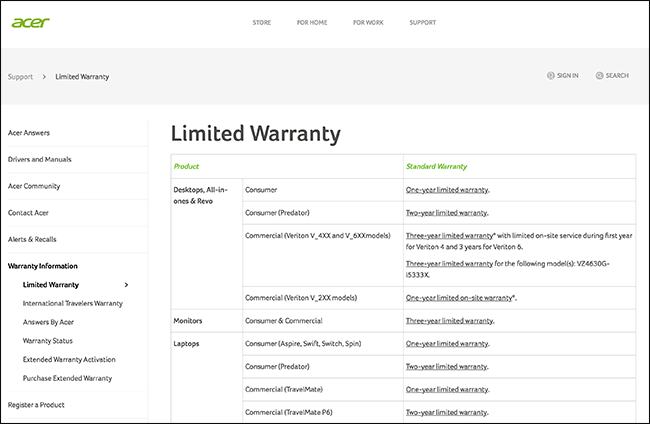Quick Links
The European Union has, in general, taken a far more hands-on approach to consumer rights than the US. If you’re in the EU, you are probably entitled to a lot more recourse than you might think when something goes wrong with your gadgets. It's not just the one-year warranty the manufacturer gives you.
What You Get with a Basic Manufacturer's Warranty
A manufacturer's commercial warranty is essentially a promise that the product you buy from them will work as they said it would for a certain period of time. If your laptop's screen dies without reason, or your phone's battery has serious issues, they agree to replace or repair it within the warranty period (usually a year or two). For example, when Samsung had the exploding Note 7 fiasco, replacement phones were covered under the manufacturer's warranty.
The problem with a manufacturer's commercial warranty is that they are free to set whatever terms they want. Sometimes only certain components will be covered, you'll need to pay a repair fee, or the warranty will have a very short duration. You will also probably need to ship your device back to the manufacturer for any repairs, or to be assessed for replacement.
Some manufacturers or retailers also offer extended warranties, which make the standard warranty's terms last for longer than the usual period, although these are seldom a good idea.
The EU Consumer Guarantee
If you live in the EU, however, you get more than just the manufacturer's warranty.
When you buy a product in the EU, you are entitled to a minimum of a two-year legal guarantee that is separate from any commercial guarantee offered by the manufacturer. This means that when you buy most tech products you actually get two guarantees: the manufacturer’s commercial guarantee and the EU consumer guarantee.
Most interestingly, the EU consumer guarantee is with the retailer (or trader) you buy the item from, not the manufacturer. This means that if you buy an Acer laptop from Tesco (basically the English Walmart), and it breaks within two years, you can bring it straight back to the shop you bought it from and they have to deal with it---not Acer. It doesn’t matter whether the shop is online or physical either, they are still responsible. You could contact Acer and claim under their commercial guarantee if it still applied, but in most cases, going through the traders will be simpler.
Also, the two-year guarantee is the absolute minimum that a trader can offer. In some countries, national law actually requires a longer guarantee; in Ireland and the UK, for example, it’s six years. You can check what the specific minimum guarantee is on the Europa.eu website.
What’s Covered By the EU Guarantee?
Now, let’s get one thing straight: the EU consumer guarantee (and also the manufacturer's warranty) isn’t some get out of jail free card for any broken device. If you drop your phone in the toilet, spill a coffee on your laptop, or otherwise damage your device through your own neglect or stupidity, you’re on the hook for any and all repairs. The EU guarantee doesn't cover accidental damage---for that, you'd need insurance (like AppleCare+). Instead, the EU guarantee covers you if the goods you buy:
- Are not fit for purpose you bought them for.
- Don’t accurately match the product description or have different qualities to the model advertised or demonstrated for you.
- Are of lower quality or have worse performance than a normal version of the same product.
- Weren’t installed correctly by the supplier, or if the instructions are deficient, the customer.
In other words, the guarantee covers you if the product turns out to be faulty or not what you were told you were getting. For tech products, you’re most likely to have to deal with screens, batteries, or other hardware that fails before it should. The nice thing is that the two-year minimum is most likely longer than the commercial guarantee the manufacturer offers.
The guarantee is only valid for defects that are presumed to be present in the product when you receive it. It’s meant to protect you from dud products rather than wear and tear. How this plays out is as follows:
- If any fault appears within the first six months that you own the product, it’s assumed that it was present when you received it and the trader is automatically liable.
- If any fault appears after the first six months but before the guarantee period has ended, you may have to prove the defect was present in the product when you received it before the trader will accept liability. However, when it comes to tech products, it's pretty easy to argue that a screen or battery that fails after 18 months was defective on delivery; the EU guarantee is just deliberately broad since it covers everything from Windows PCs to the windows in your home. Apple simply offers at least a two-year warranty in all EU countries because of this.
In other words: if you live in the EU, you already have a built-in extended warranty for everything you buy.
What You’re Entitled to Under the Guarantee
So you’ve been sold a laptop with a faulty screen, and you bring it back to the trader. What do they have to do for you?
Well, in most EU countries, there’s a thing called the “hierarchy of remedies”. The trader must first offer to repair the product, if that’s unfeasible they can offer to replace it, and finally, if that’s not a viable option, they can offer you a price reduction on an alternative product or a refund.
In all cases, the trader must offer the remedy within a reasonable time frame, without overly inconveniencing you, and without cost to you. Note, this means that if you bought a product from an online store, they are required to pay for it to be shipped back for repair, or at worst, refund you the cost of having it shipped back.
What Makes The EU Consumer Guarantee So Good
The EU consumer guarantee is a key piece of the EU’s consumer protection legislation and, in general, it offers more protection and easier solutions than the warranty offered by a manufacturer.
First, the two-year minimum is longer than the warranties offered on many tech goods by the manufacturer. For example, Samsung offers a 6 month EU warranty on earphones; the trader you buy them from, however, still has to abide by the two-year (or even longer) EU one.
Second, by making the guarantee between you and the trader, it’s much easier for you to get recourse. Rather than shipping a product off to a manufacturer somewhere, you just go back to the shop (or online store) you bought it from and they are responsible for repairing it, replacing it, or refunding you.
Finally, everything I’ve covered in this article is the bare minimum. Some EU countries have even stronger consumer protection legislation on the books. In the UK, for example, the consumer guarantee as described above lasts for six years, and is valid for both new and secondhand products.
Since you get both the EU guarantee and the manufacturer's warranty, you can choose which one you want to use when you encounter a problem. In most cases, the EU guarantee will be simpler as you can just return the product to the shop or online store you bought it from and insist it be repaired or replaced. You don't have to deal with the manufacturer's claims process. The EU guarantee also covers the product in its entirety, while the manufacturer's warranty may only cover certain components or parts.
Personally, I've only ever used the EU guarantee; it's just been the easiest for me. This, however, may not be true for everyone. If your device is still covered by both guarantees, read through the commercial warranty from the manufacturer and see how it stacks up the EU's. It probably won't be as good, but you never know.
Photo credit: wk1003mike/Shutterstock.com.




